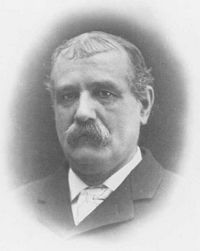Francis Amasa Walker
Francis Amasa Walker (July 2, 1840–January 5, 1897) was a United States economist and educator, as well as an officer in the Union Army during the American Civil War.
Walker was born in Boston, Massachusetts, the son of Amasa Walker. He graduated from Amherst College in 1860, where he studied law. During the Civil War, he rose from the rank of sergeant-major to that of brevet brigadier general of volunteers—awarded him at the request of General Winfield Scott Hancock. He was particularly adept at analyzing enemy troop strength and their position. Walker was wounded at the Battle of Chancellorsville, and captured at Ream's Station, where he was sent to Libby Prison.
Walker's activities after the war included stints as editor of the Springfield (MA) Republican, chief of the government bureau of statistics, director of both the 9th and 10th Census (1870 & 1880) and as U.S. commissioner of Indian Affairs (1871–72). From 1872 to 1880 he was professor of political economy at Yale; In 1878 he represented the United States at the Monetary Conference in Paris; from 1885-92 he served as president of the American Economic Association; and from 1881 to his death he was president of the Massachusetts Institute of Technology. The Walker Memorial, a students' clubhouse and one of the Technology buildings on the Charles, was dedicated in 1916. As an economist, Walker is especially known for his theories on wages and profits. He was a prolific writer, especially on economic topics, and is regarded as an original and powerful thinker. He helped to design the Stanford University campus.
Principal Works
- The Indian Question (1874)
- The Wages Question (1876)
- Money (1878)
- Money in its Relation to Trade and Industry (1879)
- Political Economy (1883)
- Land and its Rent (1883)
- History of the Second Army Corps (1886)
- Political Economy (third edition, 1888)
- Life of General Hancock (1894)
- The Making of the Nation (1895)
- International Bimetallism (1896)
- This article incorporates text from an edition of the New International Encyclopedia that is in the public domain.
Credits
New World Encyclopedia writers and editors rewrote and completed the Wikipedia article in accordance with New World Encyclopedia standards. This article abides by terms of the Creative Commons CC-by-sa 3.0 License (CC-by-sa), which may be used and disseminated with proper attribution. Credit is due under the terms of this license that can reference both the New World Encyclopedia contributors and the selfless volunteer contributors of the Wikimedia Foundation. To cite this article click here for a list of acceptable citing formats.The history of earlier contributions by wikipedians is accessible to researchers here:
The history of this article since it was imported to New World Encyclopedia:
Note: Some restrictions may apply to use of individual images which are separately licensed.
